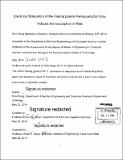| dc.contributor.advisor | Emery N. Brown. | en_US |
| dc.contributor.author | Zheng, Shu, M. Eng. Massachusetts Institute of Technology | en_US |
| dc.contributor.other | Massachusetts Institute of Technology. Department of Electrical Engineering and Computer Science. | en_US |
| dc.date.accessioned | 2014-11-24T18:42:35Z | |
| dc.date.available | 2014-11-24T18:42:35Z | |
| dc.date.copyright | 2014 | en_US |
| dc.date.issued | 2014 | en_US |
| dc.identifier.uri | http://hdl.handle.net/1721.1/91885 | |
| dc.description | Thesis: M. Eng., Massachusetts Institute of Technology, Department of Electrical Engineering and Computer Science, 2014. | en_US |
| dc.description | Cataloged from PDF version of thesis. | en_US |
| dc.description | Includes bibliographical references (pages 40-42). | en_US |
| dc.description.abstract | Despite the central role of general anesthesia in modern healthcare, the frequency of anesthesia-related morbidity resulting from the toxicity and non-specificity of anesthetic drugs remains high. Among the key behavioral states of general anesthesia is antinociception (reduced sensitivity to pain). Within the nociceptive pathway in the brain and the central nervous system, the periaqueductal gray (PAG) has been shown to be a key site that modulates antinociception responses. We hypothesize that electrical stimulation of the ventral lateral periaqueductal gray (vIPAG) in rodents reliably induces antinociception in a physiology-derived way. Rectangular electrical stimuli were applied at the vlPAG of rats at animal-specific optimal currents. We found that antinociception levels increased by 85% [69%-102%] (mean, [95% Cl]) at the 10-minute time points of 1-hour stimulations in 18 experiments across 6 animals. Antinociception neither increased nor decreased significantly over the course of the stimulation. The levels of antinociception decayed back to baseline ranges within 26 [22-31] (mean, [95% Cl]) minutes after stimulation. Our findings suggest a promising step towards the design of behavioral states in general anesthesia by manipulating directly one of the brain's natural nociceptive pathways, in addition to or in place of the current pharmacology-based anesthesiology procedures. | en_US |
| dc.description.statementofresponsibility | by Shu Zheng. | en_US |
| dc.format.extent | 48 pages | en_US |
| dc.language.iso | eng | en_US |
| dc.publisher | Massachusetts Institute of Technology | en_US |
| dc.rights | M.I.T. theses are protected by copyright. They may be viewed from this source for any purpose, but reproduction or distribution in any format is prohibited without written permission. See provided URL for inquiries about permission. | en_US |
| dc.rights.uri | http://dspace.mit.edu/handle/1721.1/7582 | en_US |
| dc.subject | Electrical Engineering and Computer Science. | en_US |
| dc.title | Electrical stimulation of the ventral lateral periaqueductal gray induces antinociception in rats | en_US |
| dc.title.alternative | Electrical stimulation of the ventral lateral periaqueductal gray induces antinociception in rats | en_US |
| dc.type | Thesis | en_US |
| dc.description.degree | M. Eng. | en_US |
| dc.contributor.department | Massachusetts Institute of Technology. Department of Electrical Engineering and Computer Science | |
| dc.identifier.oclc | 894501806 | en_US |
